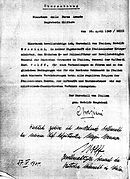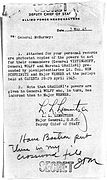Surrender at Caserta
| Instrument of Surrender of all German and RSI forces in Italy | |
|---|---|
 German delegations (at left) with Allied delegations including a Soviet representative (at right) at the ceremony in Caserta. | |
| Type | Capitulation |
| Signed | 29 April 1945 |
| Location | Royal Palace of Caserta, Italy |
| Effective | 2 May 1945[note 1] |
| Negotiators | |
| Signatories | |
| Parties | |
The Surrender at Caserta (Italian: Resa di Caserta, pronounced [ˈreːza di kaˈzɛrta]) of 29 April 1945 was the written agreement that formalized the surrender of German and Italian Fascist forces in Italy, ending the Italian Campaign of World War II.[1]
Background
[edit]Since March 1945, SS Obergruppenführer Karl Wolff, the commander of the German occupying forces in Italy, had begun negotiations for the local surrender of Axis forces in Italy. The Allies sent different negotiators, notably OSS agent Allen Dulles to negotiate the surrender in Switzerland. Wolff believed that a separate peace agreement might broke the alliance of United States, United Kingdom, and the Soviet Union, as the Allies only agreed that they will only accept unconditional surrender during the Casablanca Conference. Hearing the negotiations, the Soviet Union also want to send a Soviet representative to be part of the negotiations. But the Allies refused.
Owing in part to Allied air attacks, the German forces in Italy had received no supplies from Germany since the first week of April.[2] Since Allied aircraft had destroyed all bridges across the Po river, the Germans abandoned their heavy weapons and motor vehicles south of it during the Allied spring offensive.[3][4] What was left of the German infantry along with the RSI forces was mostly wiped out during the fighting.[4] The remaining troops had retreated across the Po using improvised transports and were reorganized by blocking detachments to man the front line and fight on, but without arms their situation was hopeless.[4]
Surrender
[edit]On 26 April, Wolff first consulted to Marshal Rodolfo Graziani, the Minister of Defence of the Italian Social Republic and Commander-in-Chief of the Army Group Liguria, to sign a surrender document of the German and RSI forces under his command equivalent to the German surrender document. Graziani signed the surrender document and gave it to Wolff and later endorsed them to Major Wenner. On 29 April, Graziani handed himself on General Crittenberger's US IV Corps.
German Commander-in-Chief of Army Group C Heinrich von Vietinghoff had noted on 28 April that fighting would cease within one or two days regardless of negotiations, the German troops having neither arms nor ammunition left.[5] Further destruction was thus unlikely, Army Group C having decided already on 11 April not to carry out Hitler's scorched earth policy.[5]
The signing ceremony was signed at Caserta. Major Schweinitz signed the surrender document on behalf of General Vietinghoff, and Major Wenner signed on behalf for SS Obersturmbannführer Wolff and Marshal Graziani, while for the Allies, the surrender document was signed by General Morgan on behalf of General Alexander. On 1 May. Graziani ordered all RSI units to surrender, meanwhile Vietinghoff ordered all German units to surrender on 2 May.
The Soviets were also present in the signing event. The Soviet Military Command send General Aleksei Kislenko to Caserta to witness the signing ceremony. After the Soviets protested of secret negotiations of the Allies and the German and RSI forces in Northern Italy.
Signatories
[edit]- Allies:
- William Duthie Morgan - on behalf of General Harold Alexander, as commander of the Allied 15th Army Group
- Axis:
- Victor von Schweinitz - on behalf of General Heinrich von Vietinghoff, as commander of the German Army Group C
- Eugen Wenner - on behalf of SS Obergruppenführer Karl Wolff, as commander of the SS police in Italy and Marshal Rodolfo Graziani, as Minister of Defence of the Italian Social Republic
Aftermath
[edit]British Field Marshal Harold Alexander in statement said that the Surrender of Caserta shortened the war in Europe by six to eight weeks and saved Northern Italy from more destruction along with tens of thousands of lives.
Gallery
[edit]Notes
[edit]- ^ May 2 was the official surrender date of all Axis forces in Italy. But the RSI forces surrendered on May 1.
References
[edit]- Citations
- ^ Stafford, David (2008). Endgame 1945 : victory, retribution, liberation. London: Abacus. ISBN 978-0349119120.
- ^ Frieser 2007, p. 1158.
- ^ Frieser 2007, p. 1156.
- ^ a b c Frieser 2007, p. 1159.
- ^ a b Frieser 2007, p. 1161.
- Bibliography
- Frieser, Karl-Heinz; Schmider, Klaus; Schönherr, Klaus; Schreiber, Gerhard; Ungváry, Kristián; Wegner, Bernd (2007). Die Ostfront 1943/44 – Der Krieg im Osten und an den Nebenfronten [The Eastern Front 1943–1944: The War in the East and on the Neighbouring Fronts] (in German). Vol. VIII. München: Deutsche Verlags-Anstalt. ISBN 978-3-421-06235-2.
{{cite book}}:|work=ignored (help)
Further reading
[edit]- Text of the Instrument of Local Surrender of German and Other Forces Under the Command or Control of the German Commander-In-Chief Southwest from the Avalon Project


